Table of Contents
Native Americans in Fiction
 |
Scott O’Dell’s Newbery Medal winner Island of the Blue Dolphins (HMH, 2010), now a classic, is the story of Karana, a Native American girl who lived alone for nearly twenty years on an island off the California coast – hunting, building a canoe, living in a house of whale bones. For ages 8-12. |
 |
In Jean Craighead George’s Newbery Medal winner Julie of the Wolves (HarperCollins, 2019), 13-year-old Julie, threatened with an arranged marriage, runs away from her Eskimo village and survives on the tundra with the help of a pack of wolves. For ages 8-12. |
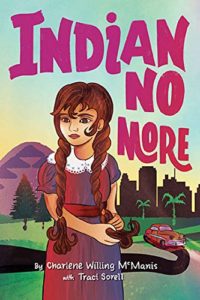 |
In Charlene Willing McManis and Traci Sorell’s Indian No More (Tu Books, 2019), set in the 1950s, ten-year-old Regina Petit and family have always been Umpqua, living on the Grand Ronde reservation in Oregon – until the federal government decrees that the tribe no longer exists, rendering them “Indian no more.” Regina’s father then moves the family to Los Angeles where Regina for the first time encounters the mainstream culture’s grasp of Indian identity – largely gleaned from the TV show The Lone Ranger – and struggles with racism. For ages 8-12. |
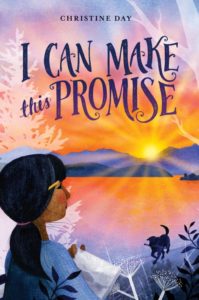 |
In Christine Day’s I Can Make This Promise (Heartdrum, 2020), Edie knows that her mother was adopted by a white couple – but knows next to nothing about her Native American heritage. Then in the attic she discovers a box filled with letters and a photograph of a woman who could be her twin – and begins to learn painful truths about Native American history and her own family’s past. For ages 8-12. |
 |
In Elizabeth George Speare’s The Sign of the Beaver (HMH, 2011), set in 18th-century Maine, young Matt’s father leaves him alone to guard their frontier cabin. When a white stranger steals his gun, Matt is left helpless – he not only can’t defend himself, but can’t hunt for food. His salvation is Atean, a Native American boy, who helps Matt survive and teaches him about his culture. As Matt’s friendship with Atean evolves, his assumptions about Indians and his understanding of their relationship with white settlers begins to change. For ages 9-12. |
 |
Tom Tingle’s Stone River Crossing (Tu Books, 2019) is a story of the rarely explored bond between Native Americans and African-American slaves. Only the Bok Chitto River separates the Choctaw nation from a slaveholder’s Mississippi plantation. When Lil Mo discovers that his mother is to be sold, he and his family – with the help of Choctaw girl Martha Tom – escape across the river to the Choctaw village. There they adapt to a new life with the help of the squirrel hunter, Funi Man, though there are still dangers – not only from slave hunters, but from an otherworldly witch owl. For ages 9-12. |
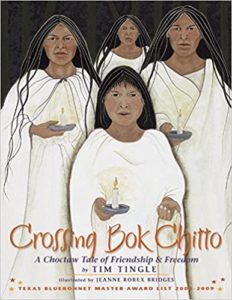 |
For a picture-book version of the story, see Tom Tingle’s Crossing Bok Chitto (Cinco Puntos Press, 2008). |
 |
In James Bird’s The Brave (Feiwel and Friends, 2020), Collin has a condition that causes him to count every letter in every word spoken to him – which makes him prey for bullies and a problem in school. His discouraged father sends him to Minnesota to live on a reservation with the Ojibwe mother whom he has never met. There, with the help of his mother, his grandmother (a ghost), some wise elders, and next-door neighbor Orenda, who believes she’s turning into a butterfly – but is actually dying of ALS – Collin comes to terms with his problems and finds himself. For ages 9-12. Though the book received some starred reviews (Booklist, School Library Journal), it hasn’t been well-received by the Ojibwe community. See this review from the New York Times and this from American Indians in Children’s Literature (AICL). |
 |
Helen Frost’s Salt (Square Fish, 2015) is the story of the friendship between two twelve-year-old boys in the Indiana Territory in 1812 – Anikwa, a member of the Miami tribe, and James, who lives with his family in the stockade near Fort Wayne. As war between British and Americans comes closer, the two find they have to decide where their loyalties lie. A novel in verse, told in the voices of both boys. For ages 10-14. |
 |
Edited by Cynthia Leitich Smith, Ancestor Approved (Heartdrum, 2021) is a collection of stories and poems centered around a pow-wow, by contemporary Native authors representing a range of nations, among them Cree, Ojibwe, Choctaw, Cherokee, Navajo, Abenaki, and more. Included is a glossary of indigenous vocabulary words. For ages 10-14. |
 |
Beth Kanell’s Darkness Under the Water (Candlewick, 2008) is the story of Molly, a half-Abenaki, half-French Canadian girl growing up in Vermont in the 1920s – where she begins to realize that the government’s eugenics project is targeting people such as her pregnant mother, who have been deemed undesirable. For ages 12 and up. From the New Yorker, see The Forgotten Lessons of the American Eugenics Movement. |
Two Kinds of Captives
 |
Lois Lenski’s Indian Captive (HarperCollins, 1995), young Mary Jemison is captured along with her family in 1758, separated from her parents and siblings, and sent to a Seneca village in western New York. There she’s adopted – and struggles to adjust to a new life, missing her family, learning a new language and new customs, forging new relationships. Ultimately Mary – now called Corn Tassel – has a chance to return home, but elects to stay with the Seneca. Based, more or less, on a true story. For ages 8-12. |
 |
Elizabeth George Speare’s Calico Captive (HMH, 2001) is the story of Miriam Willard, her sister Susanna, brother-in-law James, and their children captured by Indians in a raid during the French and Indian War and taken to Montreal. Miriam dislikes both Indians and French, though she does eventually admit that the Indians were sometimes fair and kind; and neither were French Catholics as dreadful as she had been taught to believe. (Her young nephew, Sylvanus, ultimately stays with the Indians; and a niece stays with the French.) The story is based on an actual diary, A Narrative of the Captivity of Mrs. Johnson. For ages 9-12. |
 |
In Conrad Richter’s The Light in the Forest (Vintage, 2004), John Cameron was captured as a child in a raid on the Pennsylvania frontier in 1764, adopted by the Lenni Lenape, and raised as an Indian. When the Lenni Lenape sign a treaty that requires the return of captives, fifteen-year-old John – now known as True Son – must go back to his long-forgotten white family. A story of a boy caught between two cultures. For teens and adults. The Disney movie version of The Light in the Forest (1958) is unrated, but family-appropriate. |
 |
By John Demos, The Unredeemed Captive (Vintage, 1995) is the well-researched story of a 1704 Indian attack on the village of Deerfield, Massachusetts, in which Puritan minister John Williams, his wife, and five children were captured. Williams’s wife died in captivity, but he and three surviving children were eventually freed. Seven-year-old Eunice, however, was adopted by a Mohawk family and eventually married into the tribe, steadfastly refusing all efforts to redeem her. For teens and adults. See the story of Eunice Williams from the New England Historical Society here. |
|
Family separation policies aren’t new. Beginning in the late 19th century, a U.S. government policy advocated the removal of Native American children from their families, sending them instead to government boarding schools, where children were forbidden to speak their native languages or practice native customs. Read about it here. |
|
|
From The Atlantic, see Death by Civilization, the story of the traumatic legacy of the forced Indian boarding schools. |
|
 |
In David A. Robertson’s When We Were Alone (HighWater Press, 2017), a little girl hears her grandmother’s story of her life in a residential school a long time ago – which explains why today she wears her hair long, wears colorful native clothing, speaks her own language, and – above all – values her family. For ages 5-9. |
 |
By Chiori Santiago, Home to Medicine Mountain (Children’s Book Press, 2002) is the picture-book story of two young brothers taken from their parents and sent to a government-run residential school. For ages 6-10. |
 |
In Jenny Dupuis and Kathy Kacer’s I Am Not a Number (Second Story Press, 2016), set in Canada, young Irene and her brothers, suddenly deemed “wards of the state,” are taken from their home and send to a boarding school, where Irene is given a number in lieu of a name, her long hair is cut, and she is punished for speaking her native language. Based on the childhood of Dupuis’s grandmother. For ages 7-11. |
Native Americans in Fantasy
 |
In Rebecca Roanhorse’s fast-paced Race to the Sun (Rick Riordan Presents, 2020), Dine 12-year-old Nizhoni Begay has the ability to sense monsters – one of whom proves to be her dad’s new boss, the sinister Mr. Charles, head of an oil and gas company. After her dad is kidnapped – leaving behind the message “Run!” – Nizhoni, her younger brother Mac, and best friend Davery, set off on a quest inspired by Navajo mythology, which involves dangerous challenges, a journey into the spirit realm, and the discovery of their own heritage. For ages 8-12. |
 |
In David A. Robertson’s The Barren Grounds (Puffin Canada, 2020), two indigenous kids in foster care find a portal that leads them into the frozen Barren Grounds of Misewa, a community of talking animals, who desperately need their help. For ages 10 and up. |
 |
By Drew Hayden Taylor, Take Us to Your Chief (Douglas & McIntyre, 2017) is a collection of Native-American-themed sci fi stories. A sentient computer turns to Native American spirituality; dream catchers turn dangerous; ancient petroglyphs hold the secret to time travel. For ages 11 and up. |
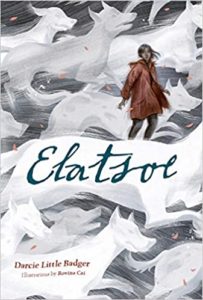 |
By Darcie Little Badger, Elatosoe (Levine Querido, 2020) is a supernatural murder mystery in which Elatsoe (Ellie), a 17-year-old Lipan Apache with a talent for ghost calling, her spectral pet spaniel, Kirby, and best friend Jay, descendant of the fairy king Oberon, join forces to track down the murderer of her beloved cousin, Trevor. And there are vampires. For ages 12 and up. |
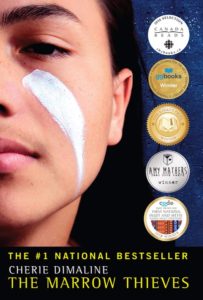 |
In Cherie Dimaline’s dystopic The Marrow Thieves (Cormorant Books, 2017), the world is ravaged by global warming, cities have crumbled into the sea, and survivors have lost the ability to dream – with the exception of the Native Americans. Indigenous peoples are being hunted for the marrow of their bones, which holds the cure to dreamlessness – and fifteen-year-old Frenchie and companions are fleeing to the north, trying to hide from the Recruiters. En route, Migwans, the leader of the group, shares stories in which he educates the younger members about indigenous history. For ages 13 and up. |
